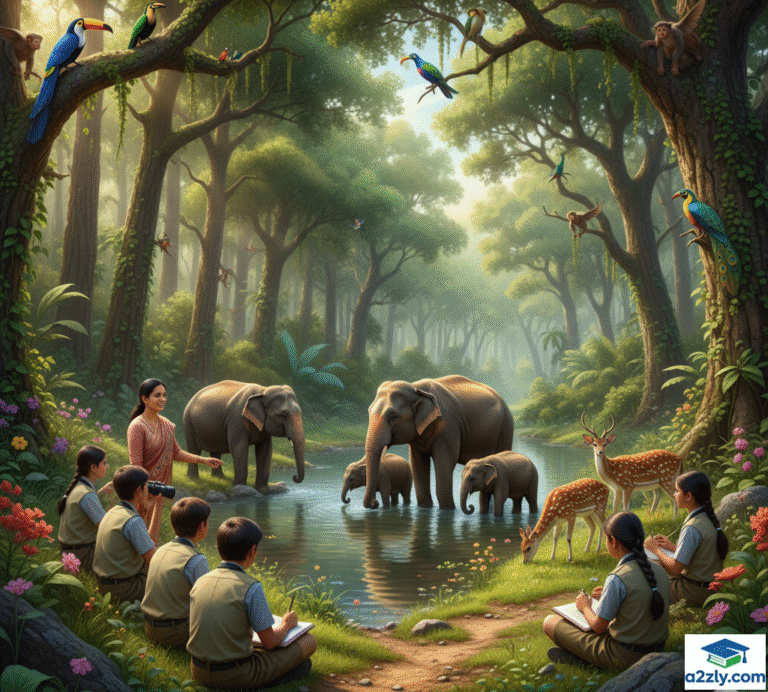🧭 Chapter Overview
Nature is like a vast orchestra — every living and non-living component plays a part, keeping Earth balanced and beautiful. From elephants roaming forests to tiny fungi breaking down waste, every organism contributes to maintaining harmony.
This chapter, “How Nature Works in Harmony”, explores ecosystems, interdependence, food chains, human impact, and conservation. By the end, you’ll understand how plants, animals, microbes, and humans are all connected in one giant network of life.
Table of Contents
🎯 Learning Objectives (NEP 2025 Competency Table)
| Competency | Learning Outcome | NEP Skill |
|---|---|---|
| Conceptual Understanding | Define habitat, population, and ecosystem | Conceptual Clarity |
| Analytical Thinking | Identify interactions among biotic and abiotic components | Critical Analysis |
| Application | Construct food chains and explain trophic levels | Problem Solving |
| Ethical Awareness | Understand human responsibility in conserving nature | Value Integration |
| Creativity | Design sustainable farming or conservation ideas | Innovation & Design Thinking |
🌿 12.1 How Do We Experience and Interpret Our Surroundings?
Every organism lives in a habitat — its natural home.
A pond, a forest, or even a tree can be a habitat, each with its own set of living and non-living components.
| Component | Description | Example |
|---|---|---|
| Biotic (Living) | Plants, animals, microbes | Fish, algae, insects, trees |
| Abiotic (Non-living) | Sunlight, air, water, soil | Rocks, temperature, rain |
These elements interact continuously.
For example, fish in a pond need oxygen (abiotic) from water, food from small plants (biotic), and space to live.
Thus, every habitat supports life through a balance of biotic and abiotic components.
🌱 Observation Activity
Visit a pond or garden.
Notice:
- How sunlight affects temperature.
- How plants grow better near water.
- How insects and birds interact.
These observations show how life thrives through interconnection.
🐘 12.2 Who All Live Together in Nature?
Nature never works in isolation — it’s teamwork!
A population is a group of the same species living together.
Different populations of plants, animals, and microbes together form a community.
Example:
A pond community may include fish, frogs, snails, lotus, and algae.
All these groups share space and resources, forming a self-sustaining ecosystem.
🌾 12.3 Does Every Organism in a Community Matter?
Yes! Every living being — big or small — plays a crucial role in maintaining ecological balance.
Example: The Pond Story
- Fish eat dragonfly larvae → fewer dragonflies
- Fewer dragonflies → more bees and butterflies
- More pollinators → more flowers and seeds
This shows how removing even one species can affect many others.
🧠 Conclusion:
Every organism, no matter how small, helps maintain balance — like one note in nature’s symphony.
🌍 12.4 What Are the Different Types of Interactions Among Organisms?
1️⃣ Biotic and Abiotic Interactions
Living beings depend on non-living elements for survival:
🌞 Sunlight → Energy for plants
💧 Water → For drinking and photosynthesis
🌬️ Air → For respiration
2️⃣ Biotic and Biotic Interactions
Organisms depend on each other for food and survival:
- Frogs eat insects
- Snakes eat frogs
- Hawks eat snakes
3️⃣ Abiotic and Abiotic Interactions
Sunlight and rainfall affect soil moisture and temperature, influencing where plants can grow.
All these together form the foundation of ecosystems.
🌎 Ecosystem: The Living Network
An ecosystem is a community of living organisms interacting with non-living surroundings.
It can be aquatic (ponds, lakes, rivers) or terrestrial (forests, deserts, farms).
Example:
In a pond:
- Plants (producers) make food.
- Fish (consumers) eat plants or smaller fish.
- Fungi (decomposers) recycle waste.
Together, they keep nature’s cycle running.
🍃 12.5 Who Eats Whom? (The Food Chain)
Every organism in an ecosystem is connected through feeding relationships.
This sequence is called a food chain.
Example (Grassland Food Chain):
🌿 Grass → 🐇 Hare → 🦊 Fox → 🦅 Eagle
| Trophic Level | Organisms | Role |
|---|---|---|
| 1️⃣ | Grass | Producer |
| 2️⃣ | Hare | Primary Consumer (Herbivore) |
| 3️⃣ | Fox | Secondary Consumer (Carnivore) |
| 4️⃣ | Eagle | Tertiary Consumer (Top Predator) |
🕸️ Food Web
In real life, food chains interconnect to form a food web, showing how energy flows through multiple pathways.
Example:
Grass → Grasshopper → Frog → Snake → Hawk
Also, Grass → Rabbit → Fox → Eagle
Nature’s web ensures that energy is never wasted — it’s transferred and recycled!
🌾 12.6 What Happens to Waste in Nature?
Nature has no garbage bins — it recycles everything!
Decomposers like fungi and bacteria break down dead plants and animals into nutrients, enriching soil for new growth.
This process is called decomposition.
Example:
- Mushrooms growing on dead trees
- Earthworms turning organic waste into humus
🌿 Key Point:
In nature, nothing is wasted — everything is reused.
🌀 12.7 How Does One Change Lead to Another?
In ecosystems, one small change can trigger many others — a chain reaction.
Example:
Pollution kills pond plants → Less oxygen → Fish die → Insects multiply → Farmers use pesticides → Soil and water get polluted again
This is known as a cascading effect — a ripple through nature’s balance.
🦋 12.8 How Do Interactions Maintain Balance in Ecosystems?
Interactions in nature — like competition, cooperation, and mutual benefit — help maintain balance.
🌸 Types of Interactions:
| Interaction Type | Description | Example |
|---|---|---|
| Mutualism | Both benefit | Bees & flowers (pollination) |
| Commensalism | One benefits, other unaffected | Orchid on a tree |
| Parasitism | One benefits, one harmed | Tick on a dog |
These relationships create equilibrium — ensuring that populations stay stable and resources renew.
👩🔬 Scientist Spotlight: A.J.T. Johnsingh
An Indian wildlife biologist who pioneered studies of tigers and prey animals.
His work proved that a healthy prey population ensures predator survival, promoting ecosystem balance.
🌏 12.9 What Are the Benefits of an Ecosystem?
Ecosystems give us air, water, food, and shelter.
They regulate climate, support biodiversity, and sustain life.
| Ecosystem | Benefits |
|---|---|
| Forest | Timber, oxygen, medicine, wildlife |
| River/Sea | Water, fish, transport, tourism |
| Grassland | Grazing, pollination |
| Mangrove (e.g., Sundarbans) | Protection from floods, carbon absorption |
UNESCO’s Sundarbans Reserve
Declared a World Heritage Site (1987) — it shields coasts, supports biodiversity, but faces threats from pollution and deforestation.
🚜 12.9.1 Human-Made Ecosystems and Sustainable Farming
Human-made ecosystems like farms and parks need careful balance.
The Green Revolution boosted food production but overuse of chemicals harmed soil and biodiversity.
Sustainable Farming Practices:
- Use organic compost (like Kunapa Jala from Vrikshayurveda)
- Crop rotation
- Natural pest control
- Reduce plastic and chemical use
🌾 Sustainable farming = Food security + Soil health + Biodiversity.
🧠 HOTS (Higher Order Thinking Skills)
- What would happen if decomposers vanished?
- How do elephants entering farms indicate ecosystem imbalance?
- Why are mangroves called “natural shields”?
- What is the difference between mutualism and commensalism?
- Can a food web exist without decomposers? Explain.
⚙️ NEP Competency Table
| Domain | NEP Skill | Example Application |
|---|---|---|
| Conceptual | Identify ecosystem components | Field study on pond life |
| Analytical | Study food web relationships | Diagram activity |
| Practical | Demonstrate decomposition | Compost-making project |
| Creative | Design sustainable farming plan | Poster or presentation |
| Ethical | Conserve biodiversity | Local clean-up drives |
⚠️ Exam Alert Box
🟢 Important Question: Explain how overuse of fertilisers harms ecosystems.
🟢 Define: Mutualism, Commensalism, Parasitism.
🟢 Differentiate: Food chain and food web.
🟢 Short Note: Role of decomposers.
🟢 Value Question: How can you personally contribute to ecosystem balance?
💡 Memory Booster Box
🔹 Biotic = Living | Abiotic = Non-living
🔹 Ecosystem = Biotic + Abiotic interaction
🔹 Producers → Consumers → Decomposers
🔹 Nature recycles everything — nothing wasted
🔹 Healthy ecosystems = Healthy humans
🔹 “Vrikshayurveda” = Ancient Indian soil science
📘 Quick Recap
✅ All life forms depend on each other → Harmony in Nature
✅ Every organism has a role — producer, consumer, or decomposer
✅ Food chains link to form food webs
✅ Decomposers recycle nutrients → No waste
✅ Ecosystem balance = Key to survival
🔗 INTERNAL & EXTERNAL LINKS
Internal Links (A2ZLY):
- Chapter 11 – Keeping Time with the Skies Notes 2025
- Class 8 Science All Chapters Smart Notes 2025
- NEP 2025 Study Material Hub | A2ZLY
External Links:

